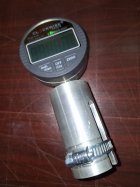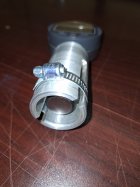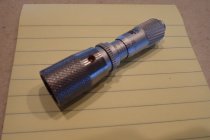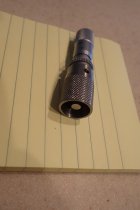View attachment 1542849
I made these for replicating headspace, cone dimensions and timing, they seem to get me within .0001-.0002
Very nice! Guessing a ball bearing on the cone would make for an easily repeatable cone and an easy measurement to boot. I guess anything you could get a repeatable measurement from would work just fine. Fixturing makes life easier in the machining world.
Paul
Very nice! Guessing a ball bearing on the cone would make for an easily repeatable cone and an easy measurement to boot. I guess anything you could get a repeatable measurement from would work just fine. Fixturing makes life easier in the machining world.
Paul
No ball bearing
I also made standards with the associated cone angles
Various diameters and lengths.
The thimble squares up the gage and is repeatable to within a few tenths. I need to make one up for non shouldered barrels.
View attachment 1542670
I'd like to do a set of these but use a 2" travel digital indicator. That way it can be zeroed on a surface plate and used to measure the action face to bolt face and then used on the tennon. You should get the same measurement except one with be + and other -.
Also use the same tool with an insert to measure bolt nose clearance which would need to be zeroed off of an existing barrel.
I'd like to do a set of these but use a 2" travel digital indicator. That way it can be zeroed on a surface plate and used to measure the action face to bolt face and then used on the tennon. You should get the same measurement except one with be + and other -.
Also use the same tool with an insert to measure bolt nose clearance which would need to be zeroed off of an existing barrel.
That is one heck of an idea.
That is one heck of an idea.
Only problem is I haven't been able to find a digital indicator with 2" travel in the price range of a hobby hack like me

Only problem is I haven't been able to find a digital indicator with 2" travel in the price range of a hobby hack like me

One big problem, gages have a center in them from the grinding operation. The flat on the micrometer thimble squares up the gage in the chamber. While a good idea I have learned there is always compromises when the term multipurpose is used.
This comes from my very early days chambering on a manual machine. Say on a Remington I take the HS measurement, make the tenon 010". short That leaves the gage exposed so no math required. For the counterbore I touch off with a boring bar and go the depth of bolt face to the nose. Automatically gives me .010" end clearance. Different ways to skin a cat. I like the shortest and simplest.
Only problem is I haven't been able to find a digital indicator with 2" travel in the price range of a hobby hack like me

Inspection certificate with graphic chart available. Easy to read large LCD digital display. Auto Power Off. Micro USB port for charging or cable data output option.
www.ebay.com
One big problem, gages have a center in them from the grinding operation. The flat on the micrometer thimble squares up the gage in the chamber. While a good idea I have learned there is always compromises when the term multipurpose is used.
This comes from my very early days chambering on a manual machine. Say on a Remington I take the HS measurement, make the tenon 010". short That leaves the gage exposed so no math required. For the counterbore I touch off with a boring bar and go the depth of bolt face to the nose. Automatically gives me .010" end clearance. Different ways to skin a cat. I like the shortest and simplest.
Very good point.
How the gauge sticks out is a big deal. Some of my gauges are not flat on the back (Manson-I can't stand that btw-gauges should be flat on the back and completely plain on the rim like a ptg). I use one layer of tape on the outside to get rid of the slop on the OD.
A micrometer would be more positive and would allow some "feel". Best case is that micrometer stem would have a foot of some diameter.
Very good point.
How the gauge sticks out is a big deal. Some of my gauges are not flat on the back (Manson-I can't stand that btw-gauges should be flat on the back and completely plain on the rim like a ptg). I use one layer of tape on the outside to get rid of the slop on the OD.
A micrometer would be more positive and would allow some "feel". Best case is that micrometer stem would have a foot of some diameter.
Dave Manson and I were talking one day about rocking gages and the resulting measurement error. He considered adding an O-ring to keep it centered. SAAMI gives us a .006" window to aim for. I know we all can do much better than that but does it matter? Not really. It goes bang (safely) and if you reload adjust the FL to match up with the chamber.
I agree in a perfect world a larger foot might or might not be better, but little to no precision would be gained. With the direct tenth reading thimbles I can repeat a measurement to within a few tenths. I can't cut a chamber closer than about .0005". We like to fool ourselves that a tenth or two or three matters but it really doesn't.
For all you part timers 1" Mitutoyo thimbles can be had for well under $50 on E-Bay. It's a worthy project. You don't need a surface plate to zero it. Any flat piece of steel will work. A ground HSS lathe bit comes to mind. Ground parallel for the mill. For the 1"-2" range I zero with a 1" standard from a 2" micrometer. If you don't have one they are cheap, $22 on E-Bay. A 1" gage ball would work also.
Dave Manson and I were talking one day about rocking gages and the resulting measurement error. He considered adding an O-ring to keep it centered. SAAMI gives us a .006" window to aim for. I know we all can do much better than that but does it matter? Not really. It goes bang (safely) and if you reload adjust the FL to match up with the chamber.
I agree in a perfect world a larger foot might or might not be better, but little to no precision would be gained. With the direct tenth reading thimbles I can repeat a measurement to within a few tenths. I can't cut a chamber closer than about .0005". We like to fool ourselves that a tenth or two or three matters but it really doesn't.
For all you part timers 1" Mitutoyo thimbles can be had for well under $50 on E-Bay. It's a worthy project. You don't need a surface plate to zero it. Any flat piece of steel will work. A ground HSS lathe bit comes to mind. Ground parallel for the mill. For the 1"-2" range I zero with a 1" standard from a 2" micrometer. If you don't have one they are cheap, $22 on E-Bay. A 1" gage ball would work also.
Shars makes both standard and digital.
Range: 0-1". You may ask for freight cost before buying tools. Precision ground threads. If you need to speak to a sales person feel free to call. Phone: 1-630-443-3244. at Fixed Prices. Product application.
www.ebay.com
Coolant, water and oil resistant to IP54 specifications. Large LCD Display. Resolution 0.00005"/0.001mm. You may ask for freight cost before buying tools. If you need to speak to a sales person feel free to call.
www.ebay.com
Here is the Mitutoyo
We are quick to respond and resolve. No accessories including standard power cord/cable. QUANTITIES AVAILABLE! We do not have power cords to provide unless they are attached to the item or unless stated that they are provided.
www.ebay.com
The digital would be nice so you can just zero it on a standard
Guess I'm old school. I know I'm old. Turn 74 tomorrow. I never have back up batteries and they always die at the most inopportune time. Digital has come a long ways from the early days.
M.Ezell
Gold $$ Contributor
Here's a variation of my EZ Chek'r lands tool that I made by changing to a 5/8 flat tip, slotting both sides of the tool and just a hose clamp to adjust the fit to be a slip fit over different tenon threads.
Makes cone depth and headspace a breeze. Just zero the indicator out on the old bbl by slipping it over the tenon. The 5/8 flat tip just uses a datum point between the two bbls. Once zeroed out on the old cone, just cut to zero on the new one. Same for headspace with a gage in the chamber. The clamp and slip fit over the tenon are to center the tool consistently. Not a big deal for a flat surface or hs gage but pretty critical for the cone, being a taper. Easy peasy.
-

20240404_090838.jpg
348.6 KB
· Views: 25
-

20240404_090830.jpg
459.8 KB
· Views: 23
The digital would be nice so you can just zero it on a standard
Yes. I bought one. I am going to make my first attempt.
Guess I'm old school. I know I'm old. Turn 74 tomorrow. I never have back up batteries and they always die at the most inopportune time. Digital has come a long ways from the early days.
I love digital. And I buy lots of extra batteries

One big problem, gages have a center in them from the grinding operation. The flat on the micrometer thimble squares up the gage in the chamber. While a good idea I have learned there is always compromises when the term multipurpose is used.
This comes from my very early days chambering on a manual machine. Say on a Remington I take the HS measurement, make the tenon 010". short That leaves the gage exposed so no math required. For the counterbore I touch off with a boring bar and go the depth of bolt face to the nose. Automatically gives me .010" end clearance. Different ways to skin a cat. I like the shortest and simplest.
I was planning on makeing a foot to screw on the end of the indicator. One for doing HS and another to do bolt nose clearance. An indicator that has an exposed stem on the back to apply pressure would be good but as Aaron suggested in another thread a couple wraps of tape around the back end of the HS gauge helps it centralise.
Conical bolts on barnards have a flat face and then a cone so bit different to a rem setup.
Also if I'm making a HS gauge of some sort I might as well make it muti purpose to check my work at very least.
Well I got off my ass and made this today to measure case protrusion on non shouldered barrels.


I just made sleeves which are precisely two inches long, and slide over the threaded tenon, and use them in conjunction with a headspace gauge and depth mike. I make gauges with a sharp contact at the datum line. I make the gauges with very little clearance at the base so there is little rocking. Some will criticize the use of a sharp edge for contact and I will admit that the use of a sharp corner does make for a fragile gauge. If I am making a gauge which I anticipate using a lot, I'll use the sharp cornered gauge to gauge the depth of a chamber which will then be used to create a gauge with a radiused contact. I have made gauges which used an o-ring to center them and I kind of like the idea (I'm kind of a fan of O-rings). However, the o-ring can hold the gauge up from contact so one has to be sure it seats for the measurement.
I also use the sleeve, in combination with a gauge which contacts an arbitrary datum line, to establish the depth on a coned breech. This if I am fitting a barrel without having the action in hand. I think I did a video on this on Will Henry's Workshop (You Tube).
Regarding reamer stops etc., I have never used such and have always just pushed the tailstock in until the reamer makes contact, then locked it down and used the graduated wheel. I do not do this with a 22LR reamer, of course. They cut too easily.
I have set up a dial gauge to verify the accuracy of the graduations on the handwheel and to establish the best way to achieve consistency on my old, cheap, machine (being considered to be old and cheap myself, it's a good fit). WH
Well I got off my ass and made this today to measure case protrusion on non shouldered barrels.
View attachment 1543859View attachment 1543860
Non shouldered barrels??
Blasphemy !!
Just kidding.

Nice gauge. Especially like the knurling.


















